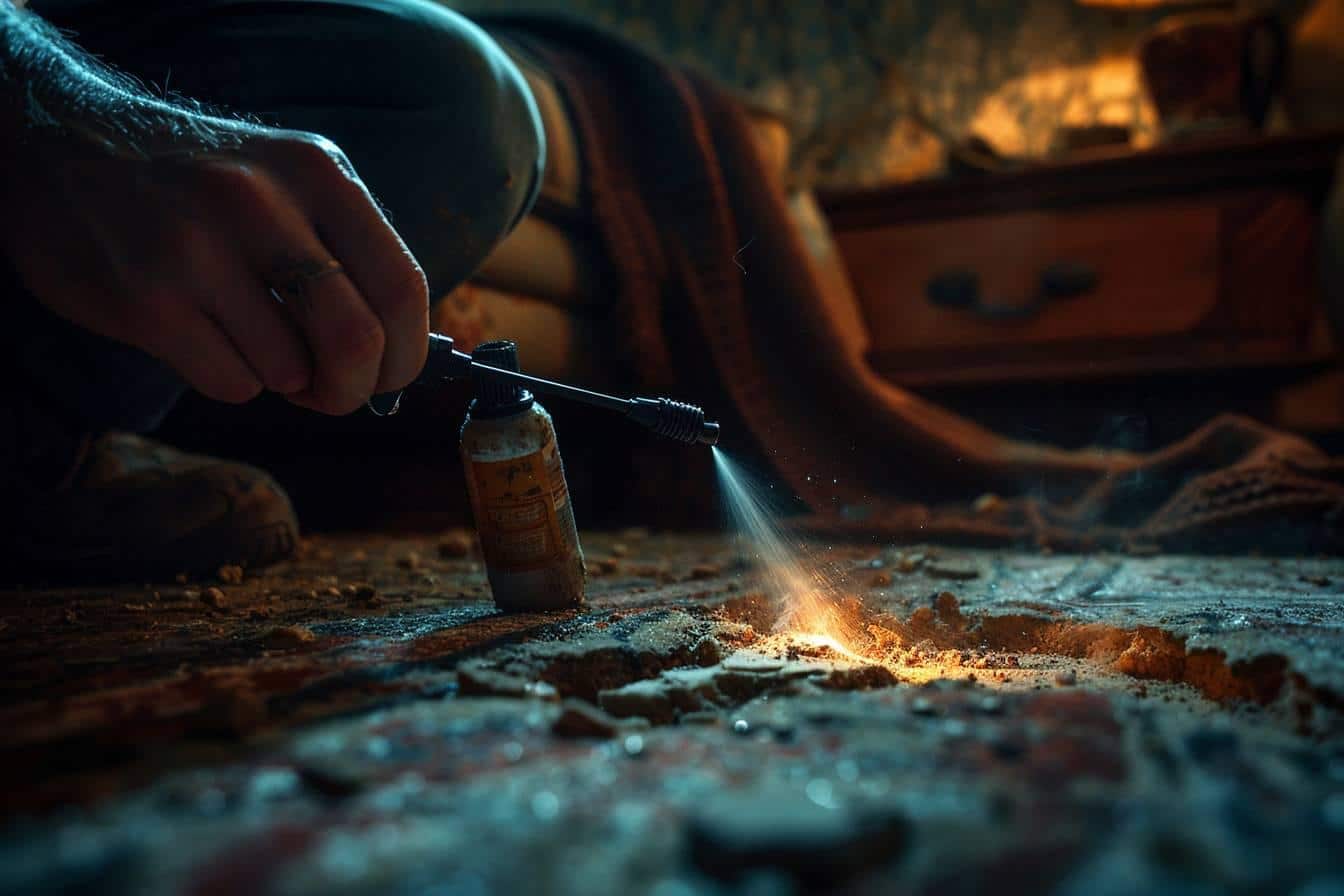Dealing with parquet fleas can be a nightmare for homeowners. These tiny pests not only cause discomfort but can also damage your beautiful wood flooring. This article will explore effective methods to eliminate and prevent parquet fleas, ensuring your home remains pest-free and your floors stay in pristine condition.
Understanding parquet fleas : Identification and behavior
Parquet fleas, also known as Tunga penetrans, are small parasitic insects that thrive in wooden floors. These minuscule pests measure about 1mm in length and have a reddish-brown color, making them difficult to spot with the naked eye. Unlike their common counterparts, parquet fleas don’t jump but instead burrow into wood, causing damage to flooring and furniture.
These wood-dwelling insects prefer warm and humid environments, making them particularly problematic in tropical and subtropical regions. However, with global warming and increased international travel, parquet fleas have become a growing concern in temperate climates as well.
Understanding the lifecycle of parquet fleas is crucial for effective control. The female flea lays eggs in cracks and crevices of wooden surfaces. These eggs hatch into larvae within 3-4 days, feeding on organic debris found in the wood. After about two weeks, the larvae pupate, emerging as adult fleas ready to continue the cycle.
Recognizing the signs of a parquet flea infestation is key to early intervention. Look out for :
- Small holes or pits in wooden surfaces
- Fine sawdust-like material near affected areas
- Tiny dark spots on the floor (flea feces)
- Unexplained itching or skin irritation
By familiarizing yourself with these indicators, you can take prompt action to address the problem before it escalates.
Effective elimination techniques for parquet fleas
Combating parquet fleas requires a multi-faceted approach. Here are some proven methods to eliminate these wood floor pests :
1. Chemical treatments : Insecticides containing pyrethrins or pyrethroids are effective against parquet fleas. Apply these products carefully to affected areas, following manufacturer instructions. Remember to ventilate the space properly and keep pets and children away during treatment.
2. Natural remedies : For those preferring eco-friendly options, consider using diatomaceous earth. This natural powder damages the exoskeletons of fleas, leading to dehydration and death. Sprinkle it liberally on affected areas and vacuum after 24-48 hours.
3. Heat treatment : Parquet fleas cannot survive high temperatures. Professional heat treatment involves raising the room temperature to about 50°C (122°F) for several hours, effectively killing fleas at all life stages.
4. Vacuuming : Regular, thorough vacuuming can significantly reduce flea populations. Use a vacuum with a HEPA filter to prevent fleas from escaping back into the environment. Dispose of the vacuum bag in a sealed plastic bag immediately after use.
To maximize the effectiveness of these methods, it’s crucial to treat not just the visible areas but also hard-to-reach spots where fleas might hide. Pay special attention to cracks, crevices, and areas beneath furniture.
| Treatment Method | Effectiveness | Environmental Impact | Cost |
|---|---|---|---|
| Chemical Insecticides | High | Moderate | Medium |
| Diatomaceous Earth | Moderate | Low | Low |
| Heat Treatment | Very High | Low | High |
| Vacuuming | Moderate | Very Low | Low |

Preventive measures to keep wood floor pests at bay
Prevention is always better than cure when it comes to parquet fleas. Implementing these preventive strategies can help safeguard your wooden floors from future infestations :
1. Maintain low humidity : Parquet fleas thrive in humid environments. Use dehumidifiers to keep indoor humidity levels below 50%. This not only discourages flea infestations but also protects your wood flooring from moisture damage.
2. Regular cleaning : Establish a rigorous cleaning routine. Vacuum at least twice a week, paying extra attention to corners and areas under furniture. Use a mop with a mixture of water and vinegar to clean wood surfaces, as the acidity deters fleas.
3. Seal cracks and crevices : Inspect your floors regularly for any cracks or gaps. Use wood filler or sealant to close these openings, eliminating potential hiding spots for fleas.
4. Natural repellents : Certain essential oils like lavender, peppermint, and eucalyptus are known to repel fleas. Create a spray by mixing a few drops of these oils with water and apply it to your floors periodically.
5. Professional inspections : Schedule annual inspections with a pest control professional. They can identify early signs of infestation and provide preventive treatments if necessary.
Implementing these preventive measures not only keeps parquet fleas at bay but also contributes to the overall health and longevity of your wooden floors. Regular maintenance and vigilance are key to maintaining a flea-free home environment.
The impact of parquet fleas on wood flooring and health
Understanding the potential consequences of a parquet flea infestation is crucial for homeowners. These tiny pests can have significant impacts on both your property and health.
Damage to wood flooring : Parquet fleas burrow into wood, creating small holes and tunnels. Over time, this can lead to :
- Weakened structural integrity of the flooring
- Unsightly appearance with visible holes and discoloration
- Increased susceptibility to moisture damage
- Potential need for costly repairs or replacement of affected areas
Health concerns : While parquet fleas primarily affect wood, they can also pose health risks to humans and pets :
- Skin irritation and itching from flea bites
- Allergic reactions in sensitive individuals
- Potential transmission of diseases in severe cases
- Stress and discomfort from living in an infested environment
The renowned entomologist, Dr. Eleanor Spicer Rice, emphasizes the importance of early intervention : « Parquet flea infestations, if left unchecked, can escalate rapidly, causing extensive damage to wooden structures and creating an unhealthy living environment. »
By addressing parquet flea issues promptly and implementing effective prevention strategies, homeowners can protect their investment in wood flooring and ensure a healthy living space. Remember, the key to successful parquet flea control lies in a combination of vigilance, regular maintenance, and swift action at the first sign of infestation.

